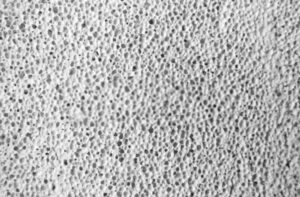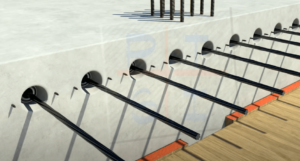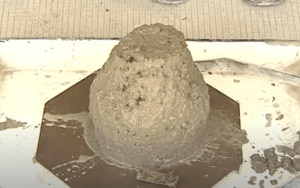The versatility, durability, sustainability, and economy of concrete make it the most widely used building material in the world. The oldest concrete found dates back to around 7000 BC. According to Wikipedia, the word concrete comes from the Latin “concretus” (meaning compact or compressed)
What is concrete?
Concrete is a building material mixed with cement, fine aggregates (sand) and coarse aggregates in water that hardens over time. Portland cement is a commonly used type of cement for concrete preparation. Concrete technology is concerned with the study of concrete properties and its practical application.
The modern history of concrete:
In the middle Ages, concrete machinery moved backwards. After the collapse of the Roman Empire in 476. After AD, the technique of making Pozzolan cement was lost until the manuscripts that described it in 1414 were found. This again sparked interest in cement construction.
Only in 1793. This technology made a big leap forward when John Smeaton discovered a more modern way to produce cement hydraulic lime. He used limestone containing clay, which was fired until it turned into clinker, which was later ground into a powder. He used this material in the historic reconstruction of the Eddy stone lighthouse in Cornwall, England.
1824 Joseph Asp din invented Portland cement by burning crushed gypsum and clay until carbon dioxide was removed. Asp din named the cement in honor of high-quality building stones excavated in Portland, England.
In the 19th century, concrete was mainly used for industrial buildings. The first widely used Portland cement in house construction in 1850-1880. In England and France. Francois Coignet added steel bars to prevent the spread of the outer walls.
Components of Concrete
Basically concrete made by three ingredients
- Portland cement
- Water
- Aggregates (rock and sand)
Portland cement
Cement is a water-based adhesive used to bond other building materials together. Used in the construction process to produce mortar and concrete. Cement and water form a paste that covers the aggregate and sand in the mix. The paste hardens and binds aggregates and sand.
Water
Water is needed to react chemically with cement (hydration) and also provide workability. The amount of water in the mixture in pounds compared to the amount of cement is called the water/cement ratio. The lower water-cement ratio makes stronger the concrete.
Aggregates
The filler material which provides the volume to concrete and reduce the cost of concrete, known as aggregate. There are two types of aggregates.
- Fine Aggregates
- Coarse aggregates
Fine Aggregates
Sand and crushed stone are the commonly used fine aggregates in cement concrete.
Coarse Aggregates
Stone ballast, gravel, gravel and brick ballast are the usual rough aggregates used in the production of concrete. The size of the aggregate depends on the type of work and the reinforcement. The size of the aggregate should be less than the distance between two consecutive steel bars in the CCR.
Production of Concrete
These steps (given below) are involved in the production of concrete.
- Batching of ingredients
- Mixing of ingredients
- Placing
- Curing
Batching of Ingredients
There are two ways to mix concrete ingredients:
- by weight
- by volume
With the exception of very large projects, they would be implemented. The basis for mixing by volume is usually one part of concrete in n parts of sand and 2 parts of ballast. Ballast is usually double compared to sand. The cement/sand ratio depends on the desired strength of the concrete. The ratio is lower when high strength is required.
The volume of a 50 kg bag of cement is 34.5 litres. When it is removed from the bags, it becomes free and increases significantly. Due to such mixing of cement depending on the volume of bulk cement, there may be less mixing of cement in the concrete. Therefore, when mixing the ingredients by volume, it is necessary to consider only a large number of bags of cement. However, if part of the bag needs to be used, this should be done by weighing.
A convenient way to measure is an open measuring box with a capacity of 34.5 litres. The required lots of fine and coarse aggregates could then be measured in portions from these boxes based on the required proportions of the ingredients. When measuring “sand”, mixing must be taken into account. Otherwise, the sandblasted concrete will not be stored.
Mixing of ingredients
Mixing of concrete means that mixing of batched ingredients to each other. There is normally two ways to mix the concrete ingredients.
- Machine mixing
- Hand Mixing
Machine mixing
It is best to mix with machines called concrete mixers.
The mixer must be thoroughly inspected for the drive system, rupture and friction controls and tin wire ropes.
It is necessary to verify the quality and suitability of aggregates, cement and water.
Check engine oil, cooling water and gasoline and fuel oil before mixing. It should be integrated if necessary. The agitator motor should run for a few minutes to warm up before being loaded with materials.
The deflector plate of the agitator drum and / or blades must be clean. The space between the drum and the blade must not exceed 25 mm to prevent coarse aggregates from slipping. If the space is large, it can be reduced by welding the steel bar between the drum and the blade.
You also need to check the drum volume. As a general rule, the ratio between the volume of the drum and the volume of wet concrete should be at least 2.5: 1. There must be enough space inside the drum to allow proper mixing.
Tilting drum mixers with deflector plate are suitable. Taps without the iron plate do not work properly. The Baffle table helps to mix by dripping the coarse filler onto the mortar at each turn.
The mixer operator must have experience and good knowledge of the required consistency of the mixture. The tap operator must be adequately informed of the risk of excess water entering the tap.
Hand Mixing
If these machines are not readily available or are too expensive to do, perfectly good results can be obtained by manual mixing if this procedure is used. For manual mixing, it is necessary to prepare a tightly articulated wooden or brick platform large enough to invert the mixture without pouring. A cement bag and the corresponding amount of sand required is distributed on this platform.
Cement and sand should then be carefully tipped with shovels at least three times to produce a uniformly colored mixture. Distribute this mixture evenly over the correctly measured amount of coarse aggregate in one layer. Now carefully transform this mixture with the blades so that the pieces of stone are evenly distributed through the mixture of cement and sand. Then the water is slowly poured onto the pile from a can equipped with a flexible tube and the rotation of the mixture continues until a practicable, smooth and uniform mixture is obtained. Only the right amount of water should be used in mixing.
Placing of Concrete
After mixing the concrete with water, it must be used within 30 minutes, i.e. before the start of the initial setting of the cement. Only a part of the concrete must be mixed with water which can be easily used in 30 minutes. In no case should the cement be remixed with water and used after 30 minutes?
After the fresh concrete has been placed correctly, it should be rammed with wooden pads or iron bars. It is made in such a way as to allow the cement mortar to penetrate in all the corners, in particular around the reinforcement bars in case of RCC works. In the case of large and important projects, this work is done by mechanical vibrators.
A few hours after laying the concrete, the exposed surfaces of the cemented part must be cured (kept wet) for at least ten days.
Curing of Concrete
Curing is a process to protect concrete from moisture loss which is required for hydration and keeps it within the needed temperature range. Hardening will increase the strength of hardened concrete and reduce its permeability. Hardening also helps reduce thermal and plastic cracks that can severely affect the durability of structures
Read Also: Different Methods of concrete curing





